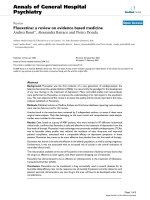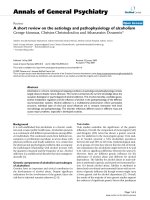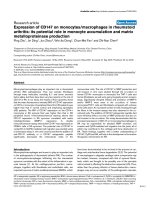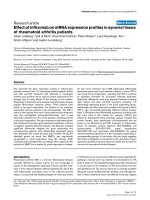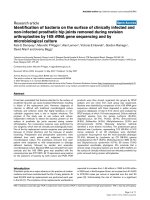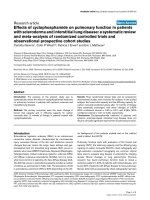Báo cáo y học: "Horizontal’ plant biology on the rise" pdf
Bạn đang xem bản rút gọn của tài liệu. Xem và tải ngay bản đầy đủ của tài liệu tại đây (57.68 KB, 3 trang )
Genome Biology 2004, 6:302
comment
reviews
reports
deposited research
interactions
information
refereed research
Meeting report
‘Horizontal’ plant biology on the rise
Yves Van de Peer
Address: Department of Plant Systems Biology, Flanders Interuniversity Institute for Biotechnology (VIB), Ghent University,
Technologiepark 927, B-9052 Ghent, Belgium. E-mail:
Published: 21 December 2004
Genome Biology 2004, 6:302
The electronic version of this article is the complete one and can be
found online at />© 2004 BioMed Central Ltd
A report on the Plant Genomics European Meeting (Plant-
GEMS2004), Lyon, France, 22-25 September 2004.
The annual meetings on plant genomics, of which Plant-
GEMS2004 was the third, are now among the most impor-
tant plant meetings in Europe. This year, almost 600
scientists from more than 30 different countries participated,
and the meeting was supported by the national programs in
plant genomics in France, Germany, the UK and the Nether-
lands, and by the French, German, Spanish and British
research ministries. This report focuses in particular on the
strengths and expectations of comparative genomics in
plants, an area that is only now starting to be fully exploited.
Comparative genomics is often praised as an extremely pow-
erful way of discovering novel biological features. A well-
known example of its power is the identification of
conserved elements, such as cis-acting regulatory elements,
in distantly related genomes: because of their conservation
over long periods of time, such elements must have some
important function. Another merit of comparative genomics
is expected to be its ability to uncover the transfer of struc-
tural and functional information from one genome to
another. This assumption is based on the observation that,
although chromosomal rearrangements can be extensive, the
genomes of different species still exhibit a certain degree of
colinearity. Keynote speaker Steve Tanksley (Cornell Univer-
sity, Ithaca, USA) argued that only through comparative and
integrative approaches will the mechanisms of evolution and
adaptation be revealed, and he stressed the importance of
moving from ‘vertical’ biology within a single species to ‘hor-
izontal’ biology across species. Currently, the genomes of at
least 10 plant species are being fully or partially sequenced.
They have been selected to complement the two model
plants whose genome sequence has already been deter-
mined, namely Arabidopsis thaliana (thale cress) and Oryza
sativa (rice). Tanksley also reported on the Solanaceae
Genome Initiative, which is studying the genomes of toma-
toes, potatoes and their relatives. One aim is to have a draft
of the tomato genome by the end of 2006. Other questions to
be tackled are how a common set of genes and proteins gave
rise to such a wide range of morphologically and ecologically
distinct species in the Solanaceae, and how a deeper under-
standing of the genetic basis of diversity can be harnessed to
better meet the nutritional needs of society in an environ-
mentally friendly way.
Comparing crops
A new genome sequence is that of poplar - officially released
only the day before the meeting. The poplar genome is
approximately 500 megabase-pairs (Mbp), divided between
19 chromosomes. Very preliminary analyses report more
than 40,000 genes. Stefan Jansson (Umeå Plant Science
Centre, Sweden), a member of the Poplar Genome Assembly
and Annotation Committee, discussed the added value of the
poplar genome for the plant community. For a long time,
poplar has been developed as a model tree for genomics, to
allow study of tree-specific traits, such as wood formation,
longevity, seasonal changes and the juvenility/maturity
transition. The poplar genome will also be of great value for
studies on natural variation, ecology and population biology,
because in all these aspects poplar is very different from
Arabidopsis. On the other hand, from a phylogenetic point
of view, poplar is relatively close to Arabidopsis, much closer
at least than Arabidopsis is to rice. The poplar and Ara-
bidopsis lineages diverged approximately 100 million years
ago, and expectations are that detailed comparison of the
two genomes will uncover many novel functional sites.
Maize is one of the most important crops and was domesti-
cated from teosinte, a group of Central and South American
grasses, in Mexico more than 7,000 years ago. Alain Char-
cosset (Station of Plant Genetics, Gif-sur-Yvette, France)
presented a detailed historical analysis indicating that maize
was introduced not once but twice into Europe: first to
southern Europe by Christopher Columbus, and again at the
beginning of the sixteenth century by the Spanish or French.
Klaus Mayer (Munich Information Center for Protein
Sequences, Munich, Germany) discussed one of the maize
genome initiatives, and the bioinformatics involved, in
which the ends of approximately 475,000 maize bacterial
artificial chromosome (BAC) clones have been sequenced,
giving a cumulative length of 307 Mb of sequence, covering
about one-eighth of the maize genome. Approximately 60%
of this is formed of repeat sequences, whereas genic regions
occupy about 7.5%.
Although the ancestor of maize was tetraploid, fewer than
half of maize genes appear to be present in two orthologous
copies, indicating that the maize genome has undergone sig-
nificant gene loss since the duplication event. On the other
hand, the number of tandem duplicates is unusually high.
Preliminary estimates, to be treated with caution, predict
more than 50,000 genes in the maize genome, which is more
than in any other organism sequenced so far. Apart from
having many genes, the maize genome is also very variable,
as discussed by Peter Bradbury (Cornell University), who
pleaded for this diversity to be exploited to improve maize
performance. Making use of the natural variation of maize
has major advantages over transgenesis, as it does not
require transformation and also avoids political problems.
Catherine Feuillet (University of Zurich, Switzerland)
showed that, despite major differences in genome size
(mainly attributable to transposable elements), chromosome
number and ploidy, gene order is generally well conserved
among the cereals, which all shared a common ancestor
approximately 70 million years ago. An example of how
information on colinearity between genomes can be success-
fully applied was presented by Beat Keller (University of
Zurich), who identified quantitative trait loci (QTLs) in
wheat for resistance against leaf rust (Puccinia triticina) and
the blotch fungus Stagonospora nodorum. The isolation of
resistance QTLs is of great importance for developing molec-
ular tools for breeding resistant crops. Keller reported that
by using microsatellite and expressed sequence tag (EST)
markers derived from wheat physical mapping projects, the
genetic map in the QTL target region has been improved sig-
nificantly, and a region spanning 7.6 centimorgans (cM)
containing the leaf-rust resistance locus has been defined on
chromosome 7DS (wheat is a hexaploid, as reflected in the
chromosome naming).
The two ESTs flanking this QTL in wheat are conserved on
chromosome 6 of rice in a region that is colinear between the
two cereals. In rice, the homologous ESTs define a physical
region of three BACs spanning approximately 300 kilobases
(kb). The colinearity between rice and wheat will now be used
to isolate possibly homologous wheat ESTs for mapping in
the wheat region of interest. Rice genome information has
thus been used to increase the number of markers in wheat,
so as to identify QTLs and disease-resistance genes. Another
example of using colinearity between genomes to identify
resistance genes was given by Pere Puigdomènech (Institut
de Recerca i Tecnologia Agroalimentàries, Barcelona, Spain),
who has identified the gene that confers resistance to melon
necrotic spot carmovirus in Cucumis melo through consider-
ing localized synteny (microsynteny) of the Cucumis genome
with that of Arabidopsis.
From simplicity to complexity
Hervé Moreau (Laboratoire Arago, Banyuls-sur-Mer,
France) described the forthcoming release of the complete
genome (approximately 11.5 Mb) of one of the smallest free-
living photosynthetic organisms, the green alga Ostreococ-
cus tauri. This is a marine photosynthetic picoeukaryote
with one nucleus, one chloroplast and one mitochondrion.
Comparison of gene order and conservation between green
algae and higher plants will be difficult, but such simplified
organisms may provide important clues about complex bio-
logical processes. This genome is indeed remarkable for the
minimization of many cellular and biological processes. For
example, Moreau showed that O. tauri, which diverged from
the base of the green plant lineage, has the smallest com-
plete set of core cell-cycle genes described to date. Therefore,
unicellular algae might be good model organisms for
improving understanding of basic but key molecular
processes. The genomes of higher plants are usually not that
simple and often contain, through gene duplication, many
copies of genes, forming large gene families.
Such partial or complete redundancy can seriously compli-
cate functional genomics studies. Gerco Angenent (Plant
Research International, Wageningen, The Netherlands) dis-
cussed one large gene family, namely the MADS-box genes.
In Arabidopsis this family has more than 100 members (in
O. tauri there is evidence for only one MADS box gene)
involved in different processes such as floral organ specifica-
tion and root, seed and fruit development. Although these
genes are the focus of much research, the function of many
of the MADS-box transcription factors they encode is still
unknown, as are their interacting protein partners (most
MADS-box proteins form dimers). Angenent uses screens
for protein-protein interactions to unravel, at least in part,
the network of protein complexes in which MADS-box pro-
teins play a role. He also uses protein-protein interaction
screens to identify orthologs in other species, which is hard
to do from sequence comparison where large gene families
are concerned. Protein interactions are much better con-
served than sequences in proteins from different species and
therefore provide more reliable evidence on orthology.
Todd Vision (University of North Carolina, Chapel Hill,
USA) reported on the divergence of expression profiles
between duplicated genes in Arabidopsis thaliana. Subtle
differences in the divergence pattern were observed between
302.2 Genome Biology 2004, Volume 6, Issue 1, Article 302 Van de Peer />Genome Biology 2004, 6:302
duplicates that arose through different processes, such as
tandem duplications, transpositional duplication or poly-
ploidy. Time seems to be a poor predictor for divergence
expression, which had mostly occurred very soon after the
duplication event. He also noted a striking asymmetry
between many duplicates in the breadth and abundance of
expression, a phenomenon that is difficult to explain with the
current models for functional divergence of duplicated genes.
Over 5 million plant EST sequences are now publicly avail-
able, with collections of more than 5,000 sequences for over
60 plant species. As Stephen Rudd (Centre for Biotechnol-
ogy, Turku, Finland) noted, these species cover most of the
plant kingdom, but with a clear bias towards the mono-
cotyledons (which include the cereals and other grasses),
and the dicotyledon subclasses Rosidae and Asteridae. EST
sequences can play an important role in comparative
genomics even though they represent a partial view of the
genome at best. The suitability of EST sequences for com-
parative genomics has been evaluated by comparing EST
sequences to the genomic scaffolds. The average rate of
sequence error is 2.2 mismatches or indels (insertions and
deletions) per 100 nucleotides. The lowest-quality sequences
are the oldest in terms of when they were sequenced,
whereas Arabidopsis ecotype differences apparently have
only a minor effect on sequence quality. As might be
expected, the clustering of the same sequences from differ-
ent sequencing experiments to build so-called unigenes dra-
matically improves the quality; when sequence clusters with
more than three members are considered, the error rate is
reduced to only 1.6 per 100 nucleotides. Rudd presented an
EST sequence-analysis pipeline called openSputnik
[], in which both patterns of domain
architectures and taxonomic restriction can be visualized,
providing a foundation for more directed expeditions into
comparative genomics.
Jan Lohmann (Max Planck Institute for Developmental
Biology, Tübingen, Germany) focused on a different aspect
of expressed genes. He discussed an international effort to
develop a gene-expression atlas of Arabidopsis designated
AtGenExpress, which will provide free access to a compre-
hensive set of Affymetrix microarray data that covers many
different experimental conditions. Lohmann discussed a
large-scale analysis of expression data from approximately
80 samples, consisting of a wide range of Arabidopsis
tissues at various developmental stages, which forms part of
this major resource. One of his main conclusions was that a
large proportion of the more than 20,000 Arabidopsis genes
are expressed in at least one developmental stage; in other
words, approximately 93% of the Arabidopsis genes are
expressed during development.
In summary, this year’s meeting again made clear that these
are the best of times for plant biologists. Besides the huge
amounts of functional genomics data being generated, the
availability of many new partial or complete plant genomes
will boost the use of comparative approaches. Undoubtedly
this will lead to many novel and exciting findings in the near
future. Stay tuned!
comment
reviews
reports
deposited research
interactions
information
refereed research
Genome Biology 2004, Volume 6, Issue 1, Article 302 Van de Peer 302.3
Genome Biology 2004, 6:302

